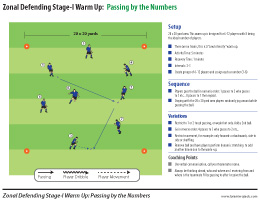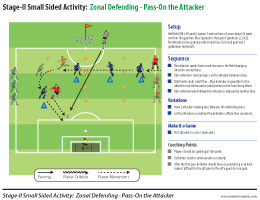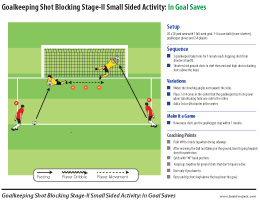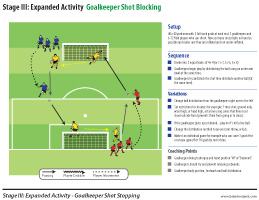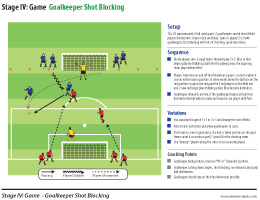USSF License D Coaching Course Notes
About USSF D License
The USSF License 'D' course is divided into two weekends, below are sessions I've designed as part of the required preparation work during the first weekend March 20-22, 2015 and for the final evaluation June 26-28th, 2015. Further down this page you can download each individual Stage of these sessions which have much more detail about running each one.
USSF Digital Coaching Center https://dcc.ussoccer.com
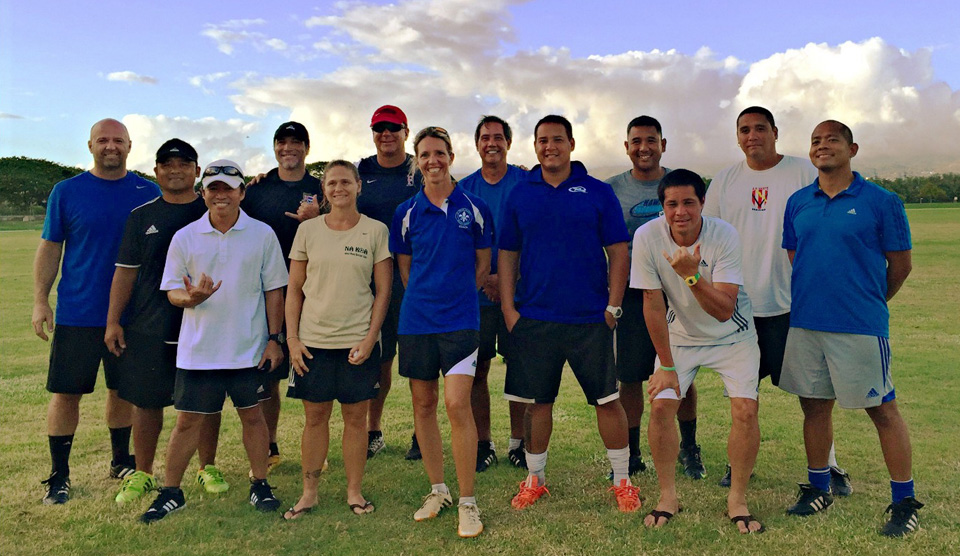
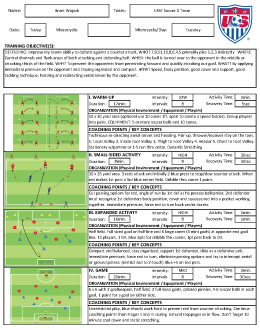
Final Evaluation Topic
Defending Topic: Improve my teams ability to defend against a counter attack.Stage I Warm-Up
Stage II Small Sided Game
Stage III Expanded Activity
Stage IV Game
Self Reflection
Pre-Course Preparation Sessions
Sports Periodization: Definition
Periodization is the systematic planning of athletic or physical training.
- The aim is to reach the best possible performance in the most important competition of the year.
- It involves progressive cycling of various aspects of a training program during a specific period.
Conditioning programs can use periodization to break up the training program into the off-season, preseason, in-season, and the postseason. Periodization divides the year round condition program into phases of training which focus on different goals.
Reference: From Wikipedia, the free encyclopedia
USSF Periodization Semantics
- Macro-cycle
Long term plan, 1 or more years (multi-year) -
Meso-cycle
Shorter-term plan, season to yearly plan. For example: Pre-Season Preparation: 4 to 8 weeks Competitive League Season: 8 to 12 weeks, Championship Season (Playoffs): 2 to 4 weeks -
Micro-cycle
Short-term plan 1 or more weeks (multi-week). This is typically the cycle of training sessions that are planned from 1 game to the next.
Planning an Single Training Session
-
Duration
The length of each activity (stage) in minutes. -
Intensity
The amount of work per unit of time. -
Intervals
The numbers of times that a work period is repeated. -
Activity Time
Duration (usually in seconds) of 1 activity period -
Recovery Time
Duration (seconds) of the rest period before resuming activity
Intensity
What variables influence this?- Activities with opponents have a higher intensity than activities without opponents.
- Smaller numbers (2v2) are more intense than larger groups (9v9)
- Restricted touches, 1 or 2 touch is more intense than unrestricted.
- Competing in a confined space is more intense than larger areas.
Number of Repetitions
What factors should be considered? Duration of each interval?- Is this a high or low load day in your planned micro-cycle?
- The longer the interval, the greater the load.
- Intensity, the higher the intensity the shorter the interval.
| Intensity | High | Med. High | Medium | Low |
| Interval | 6sec - 30sec | 30sec - 2min | 2min - 3min | 3min - 30min |
Activity Time, Recovery Time
What must be considered?A key consideration is the fitness level of your team/individuals. Example: 30sec of high intensity activity with 30sec recovery is very demanding and requires a high fitness level. Intense activities require a longer rest interval in order to recover and thus maintain quality performance and execution. Be attentive to physical signs of fatigue and adjust.
Duration = Intervals * (Activity Time + Recovery Time)
USSF Principles of Planning
-
72 Hour Rule
A full match demands 72 hours for full recovery. -
24 Hour Rule Part I
The day following a match is always a recovery day. -
24 Hour Rule Part II
The day following an overload day is a recovery day or may be substituted with a technical/tactical recovery day. -
Multiple Match Rule
2 Matches per week means no overload training that week and the week following has an underload as a maximum. -
Overload/Conditioning
Maximum 2 overload days in a Microcycle and no consecutive overload days.
Assignment: Zonal Defending
Key Coaching Tips
- Vertical runs by opponents are tracked by the defender, horizontal runs by opponents are allowed to travel between zones. In other words defenders will pass responsibility to their teammates if the attacking opponents makes a horizontal run.
- If the opponent is able to penetrate into or near the 18yd penalty box defenders should transition into man mark. This is also know as "Mixed Zonal Defending".
- Don't play a "flat zone", play a dynamic zone (track vertical runs), communication between defenders is critical.
- Keep compact (wedge) there should not be a wide gap between defenders, spacing should be symmetrical, slide over to the active area of play. The point is to intercept and get the ball back.
- Some benefits of Zonal Defense are: you are not running all over the field tracking opponents, when possession of the ball is won back players are already in position to attack they just need to open up.
Zonal Defending Stage I Warm-Up Passing by the Numbers
Training Objectives
Improve the team's ability to defend zonally but also transition into man marking when opponents make vertical runs.
- Who: Defensive backs 2, 3, 4, 5 (and maybe 6, 8 also)
- Where: Midfield and also within our penalty area.
- When: The opponent has the ball and we are trying to win possession back or prevent them from scoring.
- Why: To improve our defensive team work and communication during active play. To know when it's okay to let opponents pass through zones versus when we need to track them (for example when they make vertical runs). To prevent leaving unmarked opponents especially when they are in a dangerous area (near or within our penalty area).
Zonal Defending Stage II Small Sided Activity Pass-On the Attacker
Organization
Half field (80 x 50 yards). Layout 3 vertical lines of cones about 25 yards out from the goal line. Blue represents the back 4 (positions 2,3,4,5). Red attackers line up along either touch line. Full sized goal and 1 goalkeeper (optional). 6-12 soccer balls, and 8-12 players or more. Zonal defense in the top half track the attackers movement and pass-on responsibility.
Coaching Points/Key Concepts- Players should be sprinting at full speed.
- Defenders need to communicate constantly
- After the thru pass defender should focus on preventing or at least make it difficult for the attacker to fire off a good shot on goal.
Zonal Defending Part 1 Video Reference
This video by former US Women's National Team Coach Jeff Pill provides soccer coaching strategy and resources on soccer zonal defending.
Zonal Defending Part 2 Video Reference
Assignment: Improve Goalkeeper Shot Blocking
Improve the goalkeepers shot stopping and diving skills. Start with a goalkeepers warm-up, ball catching and throwing then transition into shooting from off the foot. Provide a variety of shot stopping activities from the ground up towards and over the head. Work on ball distribution using the hands and 3 different throwing techniques: (1) under arm bowl, (2) javelin throw, and (3) over arm bowl. Finish the session with a high paced close range 2 v 2 game where the goalkeepers will face a variety of different shots frequently during the game.
Goalkeeping Shot Blocking Stage I Warm-Up
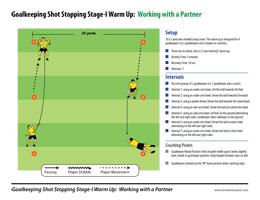
Goalkeeping Shot Blocking Stage I Warm-Up Working with a Partner
Coaching Points/Key Concepts
- Body should be in the "Ready Position": legs shoulder width apart, knees slightly bent, body weight slightly forward
- Eyes concentrating on the ball
- Hands in the gun slinger position
- Practice under arm bowl, javelin throw, over arm bowl for ball distribution
Goalkeeping Shot Blocking Stage II Small Sided Activity
Organization
20 x 20 yard area with 1 full sized goal. 3-4 soccer balls (more is better), goalkeeper gloves and 2-4 players.
Coaching Points/Key Concepts- Push off the inside leg when diving sideways.
- After receiving the ball and falling on the ground, bend top leg towards chest for protection.
- Catch high balls with "W" hands.
- Keep legs together for ground shots that don't require a dive.
- Dive only if you have to.
Goalkeeping Shot Blocking Stage III Expanded Activity
Organization
40 x 40 yard area with 2 full sized goals at each end. 2 goalkeepers and 6-12 field players who can shoot. Have as many soccer balls on hand as possible and make sure they are inflated and not under-inflated.
Coaching Points/Key Concepts- Goalkeeper technique blocking shots: "W" or "Diamond" hand position
- Punching, parrying, tipping and reduce the shooting angle using field and body position
- After successfully blocking a shot quickly distribute the ball using the under arm bowl
- Be in the "ready position" move feet quickly
- Try and prevent releasing rebounds
Goalkeeping Shot Blocking Stage IV Game
Organization
30 x 30 yard area with 2 full sized goals. At least 6 soccer balls (more is better). 2 goalkeepers and 8-12 field players. Game is played 2 v 2 with 2 goalkeepers.
Coaching Points/Key Concepts- Game pace
- Goalkeeper must reduce shooting angles.
- Quick distribution using hands or feet.
- Being in the "ready position".
- Dive only if you have to, stay on your feet.
- First team to score 5 goals wins. 1 minus point if shot misses the goal frame.
Lecture Notes from June 26th, 2015
Lecture Notes from March 20th, 2015
The Coach's Tool Kit: Managing the Moment- FLOW: Coach within the flow of the game.
- INDIVIDUAL REFERENCE: Coach the individual player as the game continues.
- NATURAL: Coach at natural stoppages
- STOP: FREEZE Coach using the "freeze" method
- CONDITIONS: Allowing the conditions of the activity to coach the theme.
What are the roles of the players?
Read the Game: How is the other team playing? (slow, fast, quick counter attacks)
- Goalkeepers need 1 on 1 coaching and training time.
- A good goalkeeper can keep your team in a game.
- Goalkeepers need plyometric training methods to become as explosive as possible
Use the USSF positional numbering system versus Left Back etc...
Encourage attacking and shooting but have basic defensive capabilities.
For Stage IV always play with even number (NO numbers up, NO neutral players)
When passing try and bypass a teammate in order to penetrate faster.
Make a trip to see the L.A. Galaxy play and while there checkout a United States U15 or other mens national team game. U.S. Under 15 Boys National Team (U15-BNT)
For Stage III always have 2 goals, in other words a counter attack goal (cones, pugg, or full size, anything will do)
Practice soccer at least 2 days per week with your team and cross train in another sport to prevent overuse injuries. If you want to practice more than 2 days that's okay but it should be low intensity individual practice in other words technical practice.
Drink lots of water to prevent injuries, only water, other drinks don't count.
Match game heart rate should be around 150-190bpm (pro level). Check into the Loughborough Intermittent Shuttle Test (LIST). The Loughborough Intermittent Shuttle Test, also known as the LIST, is a running test that includes jogging, running and sprinting, designed to simulate the physiological demands of soccer matches (Nicholas et al. 2000).
Lecture Notes Continued
No weight lift training until at least age 14, even at that age just using the players own "body weight" is good enough.
A technical training session is usually considered a "Recovery Day", don't forget extra stretching and lots of water.
Double rostering players is not a good idea, officially USSF recommends 72 hours of recovery after playing a full match.
Light easy jogging the day after a match is fine but no sprinting, some coaches believe this may reduced lactic acid after an intense match.
Always go for quality over quantity.
If players don't have good technical abilities then it is sort of pointless to train speed, endurance, strength, and tactics.
If your kid is good enough to get into the L.A. Galaxy academy the program is totally free.
Problem with Hawaii is the mainland has better competition. Players need good coaching but it's just as important developing players have good competition which demands they grow and become better themselves. In other words competition makes players better.
Before a game you should arrive on-time for a 1 hour warm-up.
Make practice competitive, use game related activities to promote competition among players during practice.
You learn more by losing than when you win.
Make your players "believe", get them to buy in.
Players in the back should coach the players in front of them and so on.
Ages 9-14 should be primarily focused on technical development and 1 v 1 duals.
Lecture Notes from Friday June 26th, 2015
Each practice session should contain "Functional Training" in other words reality based training that simulate game pace and pressure. Use conditions and restrictions to create different game scenarios.
1st Defender has to be disruptive, go in quick but don't over run, take long strides to reach the opponent with the ball, but slow down with short choppy steps as you close in and establish your body position to pocket the opponent into an area. Get close enough to make the ball carrier put his/her head down.
Defenders, recognize the attackers weak leg and force them to play with it.
Defenders, recognize when to go, move, stop, arrive... (terminology, slide, tuck-in)
Goalkeepers have to be vocal, barking orders to teammates (defenders)
Contact George before taking 'C' license
Watch videos of the U15 boys national team so you know what that level of play looks like.
Checkout the Real Salt Lake academy program
Pair players together to the know each other so well they can make "no look" passes
Don't be to negative, push the envelope but be human and keep it fun, and fair.
USMNT - 15k to sit on the bench per game/per player
Don't give up on kids you coach, you never know where the next star player will come from. Lookup Bobby Wood from Kauai
Be yourself when you coach your session, play to your strengths, coach player to their strengths.
If you see mistakes don't be afraid to coach the player, but should be relevant to the topic.
"Support" means in front and behind the ball.
Take video of your players and show them.
Young women (high school) try a 3-4-3 formation/system and high-press the opponent, that is if the opponent doesn't have the ability to kick a long ball and you have 3 really fast defenders in the back.
